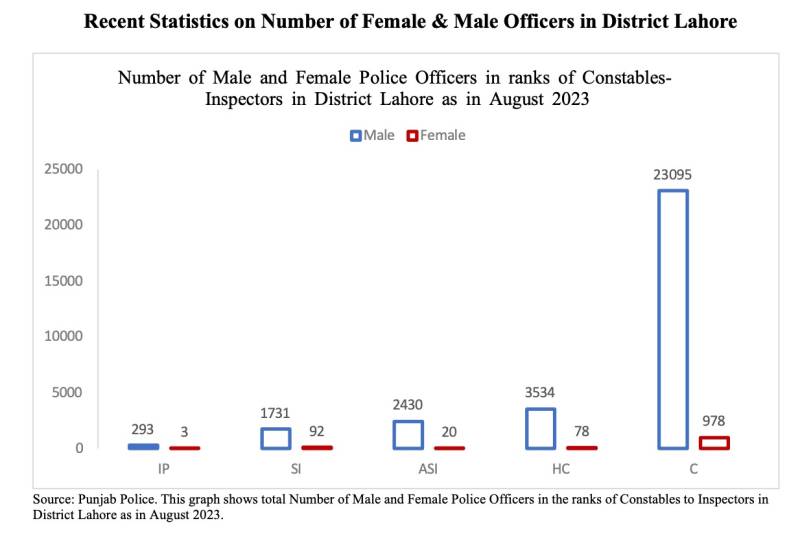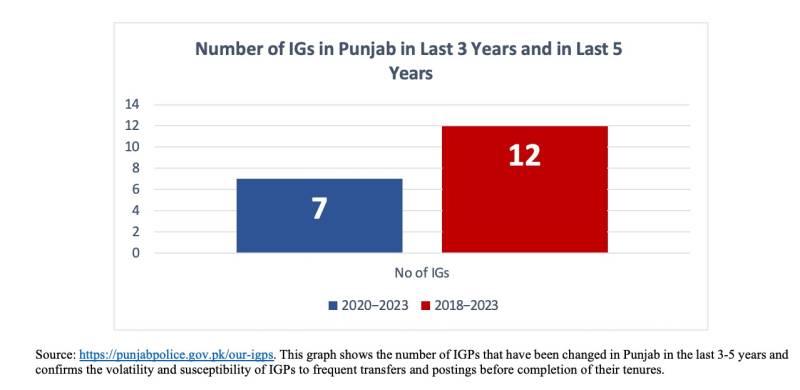In November 2023, authors Nida Usman Chaudhary and Anoshay Fazal released the second study in the series on Fair Representation in Justice Sector. The first in the series focused on interdisciplinary and comprehensive gap analysis on recruitments and appointments in the legal sector, including in judiciary, prosecution, bar councils and law firms. The current study focuses on socio-legal gap analysis of recruitments, retention and promotions of women in Lahore police.
This was a pilot study with qualitative methodology based only in district Lahore. It did not cover Punjab Police as a whole. It reflects primarily on the experiences of the women and men in police that the authors spoke to as well as of key informants who have dealt with the institution and police service in relation to reforms and gender mainstreaming in Police.
It critically examines gender disparities in Pakistan's law enforcement profession with a geographical focus on district Lahore, Punjab and highlights the pressing need to institutionalize police reforms using a gender lens. In particular, the study aimed to:
· Analyze the legal gaps in recruitment, retention and promotions that contribute to gender disparity within police in District Lahore;
· Explore the structural, social and other barriers that hinder women's recruitment, retention and promotions in police; and
· Emphasize the recommendations shared by the respondents to address these barriers.
According to this study, women constitute only 4% of the total Police in Punjab. Their lack of fair representation in the senior ranks, hinders their voices and experiences from being reflected in institutional policies and operations, however, due to gender advocacy and programs like police awam saath saath, and redefinition of police as a ‘service’ as opposed to a ‘force’ has resulted in increased awareness and desire among senior officials to mainstream gender responsive policing and enhance women’s representation in police.
Some efforts in this direction have also been taken by the department including the establishment of Women Police Councils and reduction in the minimum height required to qualify for police service for women, however, there may be further need of reform. For instance, prior to 2020, the requirement of height for officers was the same for males and female at 5'7''. On a global scale, the average height of men is around 5 feet 9 inches (175 cm), while the average height of women is around 5 feet 4 inches(162 cm). The average height for women in Pakistan is estimated to be between 5' 2.5'' – 5'6''. In the year 2020, this requirement of height was revisited and relaxed and brought down to 5'2''.
While the reduction of height for female officers from 5'7'' to 5'2'' is a welcome step towards gender mainstreaming in Police and for addressing barriers that hold women back; it must be noted that this is still 2 inches taller than the requirement for women to be recruited in the armed forces where the minimum height requirement for lady cadet course is 5 feet.
This could therefore, be identified as a gap that needs to be harmonized and which can give women of Pakistan a fairer chance for considering joining the Police service, particularly, vis a vis the armed forces, without being technically barred for this reason alone.
Other challenges related to provision of an enabling environment and infrastructure such as adequate and separate toilets, transport and daycare facilities, also remain a major issue in recruitment and retention of women in Lahore police. The study further found that institutionally, Punjab Police remained underserved in setting up daycare centers through the Punjab Day Care Fund.
Apart from these basic challenges, other peculiar findings of the study shed light on several systemic challenges that make it difficult to implement and achieve the objective of inclusion and greater participation of women in police. These also form a part of broader policy level challenges and the way the system essentially operates and functions.
For instance, the study found that frequent transfers and postings of senior officials, particularly of Inspector General (IG) Police, could cause a break in the continuity of any gender mainstreaming policies that may have been in the pipeline for weeks and months.
In Punjab in the past five years, 12 IGs had been changed despite each having a tenure of three years in law. The lack of continuity of policies and volatility of transfers of IGs also appears to be the reason why despite good efforts from development organizations on gender sensitization and other programmatic reforms for gender mainstreaming in Police, have not been as affective and transformative as they were expected to be.
For instance, the appointment of first few female SHOs to increase women's representation in senior leadership roles in police was also a person led initiative of the then IG but this policy could not be institutionalized so as to have the continuity to survive his replacement, posting or transfer.
As a result, the authors stressed on the need to ensure autonomy of police service and recommended that affirmative action for gender mainstreaming be institutionalized as opposed to remaining dependent upon person-centric initiatives to ensure continuity of policies.
The authors also highlighted the barriers in recruitment that emerge from gender-blind testing, in that women and men compete in the same pool of candidates without there being any distinction as to their genders. This practice has been criticized as one that stands in the way of affirmative action because women are significantly outnumbered by their male counterparts in a gender-blind test to make it through.
The key informants held firmly to the view that if there is a separate quota for women, their examination should also be held separately so that women are competing amongst each other and not with the general pool of candidates comprising both men and women, so that women can have a fairer opportunity of coming forward, at least to meet the quota, than they presently have, when they compete in the aggregated pool of candidates.
This does not mean that any lesser degree of exam be given to them or that there should be any compromise on merit, it simply means better management and structure of the way the exam is conducted so that women's list of successful candidates can be derived from the pool of female candidates alone rather than out of the pool comprising all the candidates.
While Punjab has the highest quota reserved for women at 15% (as compared to the 10% for other provinces), no significant efforts for fulfilling the quota are made, therefore, non-implementation and in some cases, ineffective implementation of existing laws, policies and rules is also a key issue in achieving fair representation. The authors recommended that instead of the service priding itself in being gender-blind, perhaps, it would serve the interest of fair representation more if the authorities were to be gender-intentional instead.
The study also found that, discriminatory allocation of work between male and female officers, delayed promotions, stereotypical and misogynistic attitudes of male colleagues leading to complaints against women when and if they are promoted; and the impact of excessive show-cause notices and punishments were also among some of the barriers to promotions of women in police.
For instance, women police officers are denied field postings (thereby limiting their exposure and operational experience). This paired with lack of investment in preparing and encouraging women to complete departmental exams leads to fewer women being promoted to higher ranks.
Interestingly, several female officers identified that factors like positive and powerful representation of female police officers in books and dramas had inspired some of them to join police, therefore, these should be amplified to encourage more women to join the police.
Full text of the study can be downloaded from https://www.lawyher.pk/resources/Publications



